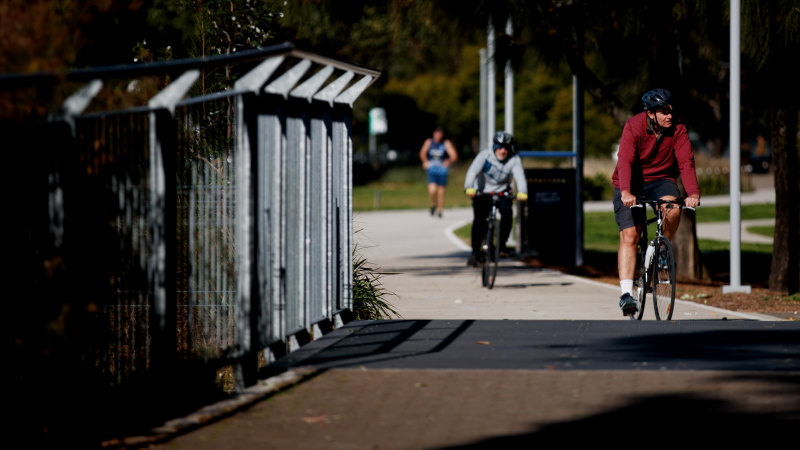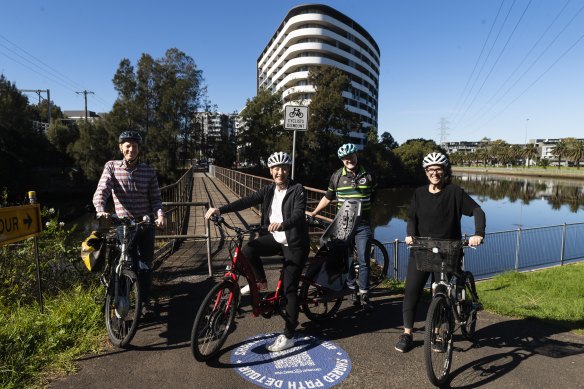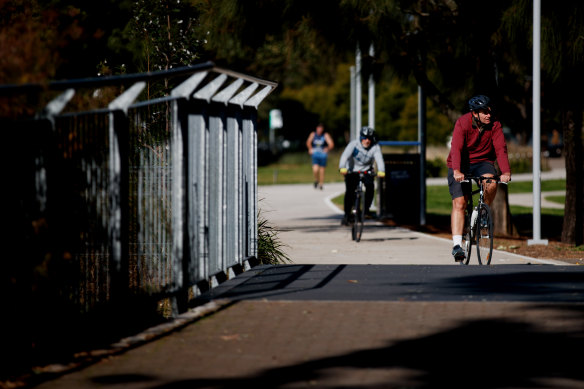Save articles for later
Add articles to your saved list and come back to them any time.
The Cooks River provides a scenic cycling route as it meanders through Sydney’s inner west towards Botany Bay, but Transport Minister Jo Haylen is often on edge while riding along its banks.
“I often feel a bit nervous about riding my electric bike along parts when there’s lots of other people riding past and plenty of kids, dogs and ibis to dodge,” she said.
John Caley, Labor MP Jo Haylen, Head of Advocacy for Bicycle NSW Francis O’Neill and Carla Stacey at the Cooks River bikepath. Credit: Rhett Wyman
Crossing the river can also be nerve-wracking, Haylen said. “The current bridges are only about as wide as a set of handlebars, it’s just not safe.”
The Minns government will provide $3 million for the upgrade of bike and pedestrian paths along the Cooks River, including $1 million for a new bridge at Tasker Park in Canterbury – one of more than 80 projects allocated $39 million under the Get NSW Active program.
Other cycling and walking projects to receive funding include the 2.6-kilometre Norwest Boulevard shared path ($3.1 million) and footpath improvements along Wentworth Park Road in Glebe ($2.25 million).
Haylen said the government wanted to provide residents in Sydney’s car-centric suburbs with safer footpaths and cycleways to schools, parks, railway stations and local shops.
“With cars travelling at higher speeds, it can be quite dangerous to ride through suburban Sydney without the safety of dedicated infrastructure, especially when drivers aren’t expecting to see you out on the road,” she said.
The state government is spending $39m upgrading bike and pedestrian paths. Credit: Nikki Short
Funding for new walking and bike paths will be given to councils such as the City of Canterbury Bankstown, which wants to reduce trips made by private vehicles from 70 per cent to 30 per cent while boosting active transport from 2.5 per cent to more than 10 per cent of journeys.
The council in Sydney’s south-west has about 75 kilometres of off-road shared paths, a spokeswoman said. “Unfortunately, much of our network is disconnected, making the journey of travelling from one side of the LGA to the other on bike quite complex.”
She said a lack of dedicated bike paths was the biggest challenge for cyclists in the area: “This means cyclists often have to ride on the road and share paths with pedestrians.”
Haylen said it was easier to build new walking and cycling infrastructure outside inner-city Sydney: “We’re not having to re-engineer narrow inner-city roads, we have plenty of room to work with.”
The projects may also face less opposition – inner-city residents and business owners have often opposed new cycleways due to concerns about construction impacts and the loss of car parking.
Haylen said the previous government wasted a lot of time and money “going back and forth, laying cycleways in the inner city, ripping them up and then laying them again”.
“That would have been a real distraction from the dire need to invest in walking and cycling infrastructure on greenfield sites,” she said.
NSW Greens active transport spokeswoman Kobi Shetty said the state government spent less than 1 per cent of its transport budget on walking paths and cycleways: “Given the United Nations has called on countries to invest at least 20 per cent of these budgets – this is nowhere near enough.”
Bicycle NSW chief executive Peter McLean said active transport infrastructure had often been forgotten or treated as an afterthought: “Private road and infrastructure owners and developers don’t have any reason to build effective active transport infrastructure as this does not benefit shareholders.”
McLean, who lives in south-west Sydney, said the outer suburbs are very car-centric because of a lack of safe walking and cycling paths.
“I am also a parent with young kids, and parents are worried about kids cycling because of the traffic,” he said.
Despite these challenges, McLean said he could often reach destinations during peak hours on his bicycle more quickly than it would take him in a car.
WalkSydney president Lena Huda welcomed the funding but said $39 million was “nowhere near enough” to build the footpaths and pedestrian crossings necessary to make walking easier and more attractive.
Huda said the Perrottet government spent $117 million under its active transport program – projects worth another $100 million missed out on funding.
“Unfortunately, governments’ underinvestment in crossings, footpaths and cycleways means there are still too many places where people don’t have the options to leave the car at home,” she said.
Huda said cheap initiatives such as lowering speed limits on local streets to 30km/h and automated pedestrian phasing at signals would improve pedestrian safety.
The Morning Edition newsletter is our guide to the day’s most important and interesting stories, analysis and insights. Sign up here.
Most Viewed in National
From our partners
Source: Read Full Article


